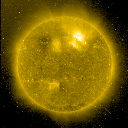Current solar activity related to Haiti earthquake?
The Sun is erupting; Earth is reeling. And we had better brace ourselves. With the increase in sunspots since December, we’re seeing more earthquakes around the world…and it’s no mere coincidence.
The surge of sunspots over the past month has culminated in the relatively behemoth 1040, actually the remains of sunspot 35, which traversed the Sun’s face about a week ago and was expected to dissipate quickly. Instead the churning magnetic field made it all the way across the Sun’s backside and, in rare fashion, turned back into a raging sunspot again, stronger and more defined than ever.
And so it appears that the long and rather strange hibernation of the Sun is coming to an end.
Our magnetosphere is being battered by particle-charged streams coming from the Sun as well as galactic cosmic rays being propelled into our solar system. Earth is like the ball in a cosmic tennis game. Her crust can bear so much buffeting. Nebraska and Oklahoma recorded earthquakes in the past month, just two odd spots along shuddering fault lines all over the planet shifting as Earth entrains with the fiery rhythm of the Sun.
In the first two weeks of the year, an active sunspot region and an equatorial, Earth-facing coronal hole have developed and become prominent, if transient, features. Geomagnetic effects are jarring Earth’s crust and weakening the supports we depend on. As solar activity grows, as it will, the quantifiable link between solar activity and earthquakes predicts that we’ll see more extremes: more earthquakes, more floods. Because of the tectonics involved, more active volcanism is likely too.
The devastation might take many by surprise, as it did a few days ago.
On the afternoon of 12 January 2010, Haiti fell, collapsing in an unanticipated snapshot of time. Port-au-Prince shook and tumbled and cried out from its deepest heart, brought down in seconds by the strongest earthquake the country has borne for two centuries. My tears are meager offerings at this time.
The Sun was also speaking loudly that day: a 15% chance of an M-Class flare was predicted (but didn’t occur), and the solar wind’s density was a relatively high 7.2 protons/cm3. We still haven’t seen an M-Class flare yet in Solar Cycle 24, but the chance is higher now than in recent memory: at the time of this writing, we face a 1-in-5 chance of experiencing an M-Class flare, and windstream density is currently just 1.6 protons/cm3.
When will the next big flare up occur? Haiti’s the latest victim, but what other regions on Earth are vulnerable to seismic and volcanic activity? What can we do to prepare?
All of this activity is conceivably leading up to a truly epic solar maximum, which should peak in the next few years – just in time for 2012. If so, my friend, we either make peace with leaving or we try to save ourselves. Therein lies the great question of our time – one we’ll surely ponder as we approach the horizon of an era.
STACE TUSSEL
See Also:
article by Alex Ansary
and this isolated abstract.
